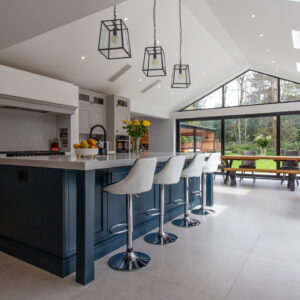
Our lives are no longer monolithic. The grand, predictable, 9-to-5 arc of the 20th century has fractured into a dynamic, unpredictable, and highly personalized mosaic of “right now.” We work from home on a Tuesday, commute on a Wednesday, and take a spontaneous trip on a Friday. Our schedules are fluid, our homes are multifunctional spaces, and our time is the ultimate currency. We have, in effect, become agile. Why, then, is our home’s core infrastructure still so stubbornly static?
We have surrounded ourselves with on-demand technology—instant streaming, immediate communication, intelligent assistants—yet our homes are often anchored by “dumb” infrastructure from a bygone era. This is most true of our heating. For generations, the standard of comfort was based on a philosophy of “brute force” and “slow inertia.” Massive, heavy systems designed to heat up slowly and stay hot all day, built for a time when a home’s occupants left at 8 AM and returned at 6 PM, like clockwork. This model is no longer just “outdated”; it is profoundly wasteful. It is a system that burns energy for hours to heat empty rooms, a blunt instrument in an age that demands precision.
The new definition of domestic luxury is not just comfort; it is responsive comfort. It is the ability of our environment to adapt to our lives in real-time. This demands a shift in material philosophy, moving away from the static and embracing the agile. We require a technology that is as fast, lightweight, and intelligent as the lives we lead. This is not a simple upgrade; it is a fundamental rethinking of how our homes serve us, starting with the very heart of their warmth.
The Physics of the “Now”: Deconstructing Material Inertia
To build a truly responsive home, we must first understand the physics that defined the old one. The traditional heating paradigm was built on a single principle: thermal inertia. This is the ability of a material to store heat. Old, high-mass systems were designed to act like a thermal battery—taking a very long time to heat up, and in turn, taking a very long time to cool down. In a static, predictable world, this was a virtue. In the modern, dynamic world, it is a critical flaw. It is the equivalent of trying to navigate a responsive, fast-paced city in a supertanker; you are always turning too late and stopping long after you’ve passed your destination.
This high inertia is the very definition of waste. It means that on a day you decide to work late, your heating system has been dutifully burning fuel for hours, pumping warmth into an empty space. When you leave for an impromptu weekend, that “thermal battery” is still pushing out heat long after you’ve locked the door. This is the central problem that modern material science has sought to solve. The rise of aluminium radiators, for example, is a direct answer to this demand for agility. Aluminium as a material possesses an incredibly low thermal inertia. It is a “super-conductor” of heat, capable of absorbing and, just as importantly, releasing thermal energy almost instantaneously.
This is not a compromise; it is a strategic advantage. Where a high-mass system might take an hour or more to make a room feel comfortable, an aluminium unit can achieve the same result in a matter of minutes. But the “cool-down” is the real hero. The moment the thermostat is satisfied, or the moment you signal “away,” the radiator stops emitting heat. It holds almost no residual warmth. This “on-a-dime” responsiveness is the key. It means you are, for the first time, heating only the space you are in, for only the time you are in it. It is the end of “pre-heating” an empty house. It is the beginning of true, on-demand thermal precision.
The Efficiency Revolution: Precision Over Brute Force
This material agility forces us to completely redefine what “efficiency” means. For decades, “efficiency” was marketed as the ability to “hold” heat. This was a narrative built around the limitations of old materials. The new, and far more accurate, definition of efficiency is precision. True efficiency is the elimination of waste, and there is no greater waste than heating a room that nobody is in. The “brute force” method of high-mass systems is inherently inefficient because it cannot respond to change. It is a one-size-fits-all solution dumped onto a world of unique, ever-changing schedules.
This is where the physics of aluminium becomes a financial and environmental game-changer. These modern systems are not just fast; they are incredibly “low-water-content.” A traditional, heavy system can require a vast amount of heated water to circulate through its large internal chambers just to begin the slow process of warming the unit. An aluminium radiator, by contrast, uses a fraction of the water. The boiler’s job is no longer to heat a massive, sluggish tank and a network of heavy iron. Its job is to heat a very small, precise amount of water, which then instantaneously transfers its energy to the radiator’s conductive surface.
This is the technology that finally unlocks the full potential of the “smart home.” A smart thermostat paired with a high-inertia, “dumb” system is a placebo. The thermostat can be as “smart” as it wants, but when it tells the system to heat up, the homeowner still has to wait an hour. It’s a “smart” brain screaming at a “slow” body. But when you pair that same smart thermostat with a highly responsive, low-inertia system, the “smart” command is executed immediately. This is what enables true, next-generation energy management. It allows for “geofencing”—your heating system can genuinely turn on when your phone’s GPS registers you are ten minutes from home. It can intelligently shut down a guest room the moment the guest leaves. This synergy between smart software and responsive hardware is the new frontier, a partnership that delivers an unparalleled reduction in energy consumption by ensuring not a single kilowatt of heat is ever generated without a precise, immediate purpose.

The Unburdened Wall: Architectural and Design Freedom
The revolution is not just functional; it is structural and aesthetic. The “heavy” nature of old heating systems was a literal, architectural burden. A single, large, high-mass radiator can weigh hundreds of pounds, and often more when filled with water. This weight severely restricted their placement. They had to be placed on “load-bearing” floors, almost always on external walls, and required significant structural consideration. Installing one on an upper floor was a major engineering project. Mounting one on an internal partition wall was simply impossible. This created a rigid, inflexible “visual language” for our interiors; the heater always went “there.”
Aluminium, by contrast, is a material of profound lightness. It is a fraction of the weight, even when filled with its minimal water content. This lightness is an architect’s dream. It is a liberation. Suddenly, the radiator is unburdened from the floor. It can be mounted securely and safely on any wall, including simple drywall partitions. This simple fact completely rewrites the rules of interior design. You are no longer designing a room around the heating system. You are integrating the heating system into your design.
This material freedom has led to an explosion in aesthetic innovation. Because aluminium can be extruded, it can be formed into shapes that are simply impossible to achieve with casting. The old, clunky forms of the past have given way to elegant, slender vertical panels that draw the eye upward and create a sense of height. Designers can now create minimalist, flat-panel radiators that blend seamlessly into a modern wall, or even bold, sculptural “statement pieces” that act as functional art. The radiator is no longer a “utility” to be hidden; it is a “feature” to be celebrated. This lightness, both physical and visual, allows for a more fluid, creative, and personalized approach to interior architecture.
The Circular Promise: A Lifecycle of True Sustainability
In our increasingly climate-conscious world, an object’s “end of life” is just as important as its operational efficiency. The narrative of sustainability is complex, but the equation for “legacy” materials, while strong on “longevity,” often ignores the massive “embodied carbon” required for their initial creation—the immense energy needed to mine, smelt, and cast heavy, dense objects. Their “re-usability” is often a craft-level, salvage-based process, not a true, industrial-scale circular economy.
Aluminium offers a different, and arguably more modern, sustainability promise. It is one of the most recycled and most recyclable materials on the planet. The energy required to recycle aluminium is a mere 5% of the energy needed to create “primary” aluminium from bauxite ore. This is not a niche, craft-level process; it is a core part of the global materials economy. As a result, the vast majority of aluminium radiators currently being manufactured are already composed of a very high percentage of recycled content. They are “green” from the moment they are born.
This creates a powerful, two-pronged sustainability narrative. First, the product is created in a “closed-loop” system, utilizing recycled materials and drastically reducing its initial embodied carbon footprint. Second, its operational efficiency, as discussed, is based on the precision of “on-demand” heating, which significantly reduces the user’s daily energy consumption. This is a complete lifecycle solution. It is a product born from a circular economy that, in turn, helps the homeowner reduce their personal energy footprint every single day. This combination of a “green” manufacturing process and “green” daily operation represents a truly holistic and modern approach to sustainability, one that aligns our domestic choices with our global responsibilities.
Conclusion: The On-Demand Sanctuary
We have moved beyond the era of the static, one-size-fits-all home. The new standard of domestic comfort is one of agility, intelligence, and personalization. We demand that our homes, like our technology, be responsive to our needs, not the other way around. To cling to slow, high-inertia systems in this new, fast-paced world is to chain ourselves to a wasteful and frustrating past.
The shift to a more responsive material like aluminium is not just a technological upgrade; it is a philosophical one. It is the understanding that true efficiency is precision. It is the freedom to partner our smart technology with equally “smart” hardware. It is the architectural liberty to place warmth where we want it, not where the floor joists demand. And it is a commitment to a sustainable, circular economy that values both recycled materials and the reduction of daily energy waste.
The modern sanctuary is not a “dumb” box that we heat; it is an agile ecosystem that responds with us. By embracing the physics of “now,” we are finally ableto build homes that are not just warm, but are also smart, fast, beautiful, and truly, genuinely efficient. We are creating the on-demand sanctuary, and it is built on a foundation of intelligent, lightweight, and responsive warmth.




